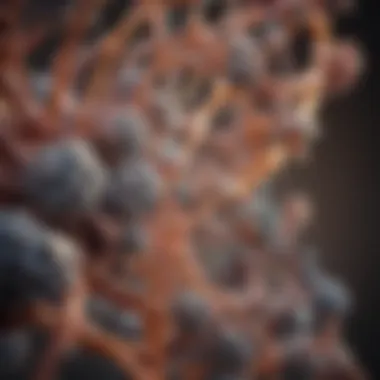Exploring the Diverse Types of Proteins and Their Roles


Intro
This article aims to deliver a thorough understanding of proteins, which are fundamental molecules in all biological systems. Proteins are essential to numerous processes, including enzymatic reactions, structural integrity in cells, and signal transduction. Understanding the various types of proteins is crucial for anyone engaged in biological research or health sciences, as it informs how these molecules influence living organisms.
Proteins can be broadly classified based on different criteria. They can be categorized by their structure, function, and source. Structural proteins, for instance, provide support in tissues, while enzymes are proteins that catalyze biochemical reactions.
Importantly, proteins also play significant roles in health and disease. For example, misfolded proteins can lead to conditions like Alzheimer's. Thus, studying proteins can illuminate paths for therapeutic interventions and enhance our understanding of cellular mechanisms.
The subsequent sections will explore these classifications, features, and biological implications in detail, aiming to provide a holistic view of protein biology.
Foreword to Proteins
Proteins are fundamental macromolecules in all forms of life. They play critical roles in various biological processes. Understanding proteins is essential for anyone in life sciences. This section will cover the definition of proteins and their significance in biological systems.
Definition of Proteins
Proteins are large, complex molecules composed of long chains of amino acids. These amino acids are linked by peptide bonds. The sequence of amino acids determines a protein's unique structure and function. There are twenty standard amino acids that can combine in numerous ways. This diversity allows for the vast range of protein functions found in nature.
Proteins can be categorized based on their structure and function. Some proteins serve as enzymes, facilitating biochemical reactions. Others serve as hormones, which regulate physiological processes. Additionally, proteins provide structure to cells and tissues. In summary, proteins are not just building blocks of the body but play crucial roles in almost every process.
The Importance of Proteins in Biological Systems
The importance of proteins cannot be overstated. They perform a myriad of functions that sustain life. For instance, enzymes are proteins that speed up reactions necessary for metabolic processes. Hemoglobin, another protein, transports oxygen in the bloodstream. Furthermore, proteins play vital roles in the immune system, as antibodies are proteins that help fight infections.
"Proteins are the workhorses of the cell, involved in everything from catalysis to structural support."
In addition to their functional roles, proteins also contribute to cell signaling. They communicate biochemical signals necessary for maintaining homeostasis. Understanding how proteins function and interact is critical for fields like biochemistry, medicine, and biotechnology. This makes an exploration of proteins relevant not just in the context of biology but also in a broader health and scientific perspective.
Classification of Proteins
Understanding the classification of proteins is fundamental in biochemistry and molecular biology. By categorizing proteins, researchers can grasp their diverse functionalities, which impact biological processes. This classification has implications in various fields, including medicine, nutrition, and biotechnology. It helps to identify the roles proteins play in living organisms and the relationships between structure and function. Consequently, this can guide research and development in health-related disciplines and industrial applications.
Based on Function
Enzymatic Proteins
Enzymatic proteins are crucial for catalyzing biochemical reactions. They lower the activation energy required for reactions, making processes faster and more efficient. The key characteristic of enzymatic proteins is their specificity; each enzyme typically catalyzes one type of reaction. This specificity makes them essential for metabolic pathways. Their uniqueness lies in their ability to facilitate reactions under mild conditions, unlike chemical catalysts, which often require extreme conditions. The advantages of enzymatic proteins include their efficiency and ability to regulate metabolism, though their activity can be affected by factors like temperature and pH.
Structural Proteins
Structural proteins provide support and shape to cells and organisms. Collagen and keratin are prime examples. These proteins are characterized by their fibrous nature, which provides tensile strength. In this article, highlighting structural proteins is beneficial as they are vital for forming tissues, such as skin, cartilage, and bones. Their unique feature is their ability to form strong, stable structures. However, their rigidity can also be a disadvantage, as it limits flexibility in some contexts, impacting tissue adaptability.
Transport Proteins
Transport proteins are responsible for moving substances across cell membranes and within cells. Hemoglobin is a well-known example, transporting oxygen in the bloodstream. A crucial characteristic of transport proteins is their ability to bind specific molecules, allowing for selective transport. They are beneficial as they ensure that essential substances are delivered where needed, contributing to homeostasis. However, transport proteins can be limited by their capacity to carry substrates and may become saturated at high concentrations, reducing efficiency.
Antibodies
Antibodies, or immunoglobulins, are specialized proteins crucial for immune response. Their primary role is to identify and neutralize pathogens such as bacteria and viruses. A key characteristic of antibodies is their specificity for antigen binding. This makes them invaluable in protecting the body from disease. In this context, highlighting antibodies is important as they play a significant role in immunology and therapeutic developments. Their unique feature is their ability to undergo affinity maturation, improving their binding capacity over time. However, this specificity can also lead to challenges in autoimmunity, where antibodies mistakenly target the body's own cells.
Regulatory Proteins
Regulatory proteins play a role in gene expression and cellular activity. Proteins like transcription factors fall into this category. Their primary characteristic is their ability to bind to DNA and influence gene transcription. Understanding regulatory proteins is crucial for this article, as they help decipher the complexities of gene regulation. Their unique feature is their modular nature, allowing them to interact with various other proteins and elements within the cell. While beneficial for regulating complex systems, their dysregulation can lead to disorders, such as cancer.
Based on Structure
Globular Proteins


Globular proteins are soluble and often spherical in shape, which makes them functional in various biological processes. They include enzymes and hormones. Their key characteristic is their versatility in function, stemming from their ability to fold into specific three-dimensional structures. This is beneficial for biological activities involving binding sites and interactions with other molecules. However, their stability can be a disadvantage, as many globular proteins are sensitive to temperature or pH changes.
Fibrous Proteins
Fibrous proteins are characterized by their elongated shapes, providing structural support. Examples include collagen and silk. Their key characteristic is their strength, which is essential in connective tissues and muscle fibers. Highlighting fibrous proteins in this article is important because of their role in maintaining the integrity of biological structures. Their unique feature is their resistance to stretching. However, this rigidity can limit the dynamism required for activities involving movement.
Membrane Proteins
Membrane proteins reside within or on cell membranes, playing key roles in transport and signaling. They are characterized by their interaction with lipids and hydrophilic environments. This specificity is beneficial as it helps govern cellular communication and substance movement. The unique feature of membrane proteins lies in their amphipathic nature, enabling them to integrate into lipid bilayers. However, their extraction for study can be challenging and may alter their function due to the dependence on membrane context for activity.
Based on Origin
Animal Proteins
Animal proteins originate from animal sources and are typically complete proteins. This means they contain all essential amino acids necessary for human health. Their richness in essential nutrients makes them an important dietary component. Highlighting animal proteins is beneficial for discussing dietary choices and health implications. A unique feature is their high bioavailability, which ensures efficient use in the body. However, concerns about ethical sourcing and environmental impact make their consumption a point of contention.
Plant Proteins
Plant proteins are derived from plants and often considered incomplete as they may lack one or more essential amino acids. However, they provide a valuable source of nutrition, especially for vegetarians and vegans. Their key characteristic is their abundance in fiber and other beneficial compounds, which aid in digestion and overall health. This makes them a popular choice for a balanced diet. Unique features include lower saturated fat, but protein quality might be a disadvantage if not properly combined.
Microbial Proteins
Microbial proteins, derived from fungi and bacteria, are gaining attention for their potential in sustainable protein production. They often serve as functional foods or supplements. Their key characteristic is their rapid growth and high yield in culture conditions. Highlighting microbial proteins is crucial in discussions on food security and alternative protein sources. Their unique feature is their adaptability to growth on various substrates. However, they may lack some essential amino acids typically found in higher organisms, which can be a drawback.
Protein Structures
Understanding protein structures is crucial for comprehending the wide-ranging roles proteins play in biological systems. Protein structure determines a protein's function, stability, and interaction with other biological molecules. The structures of proteins can be categorized into four levels: primary, secondary, tertiary, and quaternary. Each level of structure provides insights into the complexity and versatility of proteins, thus shaping our understanding of their functionality.
Primary Structure
The primary structure of a protein refers to the linear sequence of amino acids in the polypeptide chain. This sequence is determined by the genetic code and plays a pivotal role in deciding how that protein will fold and function. The order of amino acids in the primary structure dictates the chemical properties of the protein, influencing how it interacts with other molecules.
Secondary Structure
The secondary structure involves local folded structures that form within a protein due to hydrogen bonding between backbone atoms. Two common types of secondary structures are alpha helices and beta sheets, each serving unique purposes in the stability and functionality of proteins.
Alpha Helices
Alpha helices are a type of secondary structure characterized by a right-handed coiling of the polypeptide chain. This structure is formed through hydrogen bonds between every fourth amino acid.
- Key Characteristic: The coiled nature of alpha helices provides a compact structure that can fit well within a larger protein complex.
- Benefits: Their stability due to internal hydrogen bonding makes them popular in globular proteins, contributing to overall structural integrity.
- Unique Feature: Their ability to integrate well into membranes or binding sites makes alpha helices an attractive choice for many functional proteins.
- Disadvantages: However, their rigidity might limit flexibility in certain scenarios.
Beta Sheets
Beta sheets consist of groups of strands lying next to each other, held together by hydrogen bonds between the strands. This structure can be parallel or antiparallel, depending on the directionality of the strands involved.
- Key Characteristic: The extended nature of beta sheets allows for greater surface area, which can be vital for interactions with other proteins or molecules.
- Benefits: This structure is beneficial for providing strength and stability, often found in fibrous proteins such as silk.
- Unique Feature: Their arrangement can lead to a more diverse range of interactions with ligands or other proteins, making beta sheets pivotal in complex biochemical pathways.
- Disadvantages: The formation of beta sheets is sometimes energetically unfavorable, which may complicate protein folding processes.
Tertiary Structure
The tertiary structure refers to the overall three-dimensional shape of a protein, formed by the folding of the polypeptide chain into specific arrangements. Interactions among the side chains of the amino acids contribute to the stability of this structure. Factors such as hydrophobic interactions, electrostatic interactions, and van der Waals forces play significant roles in determining the tertiary architecture.
Quaternary Structure
Quaternary structure involves the assembly of multiple polypeptide subunits into a single protein complex. This multi-subunit formation allows for greater functionality and regulation. Hemoglobin is a classical example, where four subunits work together to transport oxygen in the blood. The interactions between subunits are crucial for the stability and functionality of the protein.
By understanding protein structures, researchers can manipulate proteins for various applications, enhancing drug design, synthetic biology, and biotechnology.
Functions of Different Proteins


Understanding the functions of proteins is vital for appreciating their roles in living organisms. Proteins serve a plethora of functions which are fundamental to life. They catalyze biochemical reactions, support structure, transport molecules, regulate biochemical pathways, and respond to signals. This diverse functionality underscores their relevance in both biological systems and human health, making them crucial to study.
Catalysis and Enzyme Function
Enzymes are a specific type of protein that facilitate biochemical reactions. They lower the activation energy required for reactions, thus speeding up processes that are essential for life. Each enzyme is specific to its substrate, which enhances the efficiency of cellular processes. For instance, amylase breaks down starch into sugars, highlighting the specificity and importance of enzymes in metabolism. Without enzymes, many biochemical reactions would proceed too slowly to sustain life.
Transport and Storage Functions
Proteins also play a role in transporting and storing molecules within organisms. Hemoglobin, found in red blood cells, is a prime example that transports oxygen throughout the body. Another important protein, myoglobin, stores oxygen in muscle cells. Additionally, proteins like albumin in blood carry fatty acids and hormones. This transport function is essential for maintaining homeostasis and supplying energy and nutrients to cells. Furthermore, proteins can store essential substances; for example, ferritin stores iron, releasing it when needed.
Structural Support
Certain proteins provide structural support to cells and tissues. Collagen, the most abundant protein in animals, forms a framework for bones, tendons, and skin. It gives strength and elasticity, which is crucial for maintaining the integrity of bodily tissues. Keratin, another structural protein, is found in hair, nails, and the outer layer of skin, providing protection and rigidity. These proteins are integral in maintaining physical stability and resilience in biological systems.
Regulation and Signaling
Proteins also function in cellular signaling and regulation. Hormones, such as insulin and growth hormone, are proteins that coordinate and regulate physiological processes. They interact with specific receptors on target cells, initiating a cascade of cellular responses. Additionally, proteins like transcription factors regulate gene expression by binding to specific DNA sequences, influencing how genes are expressed within a cell. Regulatory proteins thus play an essential role in ensuring that cells respond appropriately to internal and external stimuli.
"The myriad functions of proteins not only define their biological roles but also highlight their necessity in health and disease."
In summary, proteins are indispensable in various cellular functions. They act as catalysts, transporters, structural elements, and regulators, significantly impacting biological processes and health. Understanding these functions deepens our insights into protein biology, which is essential for fields ranging from medicine to biotechnology.
Sources of Proteins
The sources of proteins are fundamental when considering dietary choices and nutrition. Proteins can be sourced from various origins, each offering unique benefits, nutritional profiles, and considerations. Understanding these sources is crucial for students, researchers, and professionals in fields related to nutrition, biology, and health. This section discusses the three main categories of protein sources: animal, plant, and synthetic.
Animal Sources of Protein
Animal sources of protein are perhaps the most recognized. Foods such as meat, fish, dairy, and eggs are rich in protein and often contain all essential amino acids. Essential amino acids are the building blocks that the body cannot produce; therefore, they must be acquired through diet.
Key Points about Animal Proteins:
- Complete Protein: Most animal proteins are complete proteins, meaning they provide all essential amino acids in adequate amounts.
- Bioavailability: The body tends to absorb and utilize animal-based proteins more efficiently than some plant-based proteins. This high digestibility can be a significant advantage in meeting protein needs.
- Nutrient Density: Foods like lean meats and fish are also rich in other essential nutrients, such as iron, zinc, and vitamin B12.
However, it's also important to consider the potential downsides. Some animal sources can be high in saturated fats and cholesterol, which may pose cardiovascular risks. Therefore, selecting lean cuts and managing portion sizes is advisable.
Plant Sources of Protein
Plant sources of protein have gained attention due to their role in health and sustainability. Beans, lentils, nuts, seeds, and whole grains are excellent plant-based protein options. These foods can provide substantial protein, though they often lack one or more essential amino acids.
Important Considerations for Plant Proteins:
- Incomplete Protein: Most plant proteins are considered incomplete as they do not contain all nine essential amino acids. However, combining different plant proteins throughout the day, such as rice and beans, can yield complete protein intake.
- Health Benefits: Diets high in plant protein can reduce risks of certain diseases, including heart disease and obesity, due to their fiber content.
- Sustainability: Plant-based diets are generally associated with lower environmental impacts, promoting sustainability.
Synthetic and Novel Protein Sources
In recent years, synthetic and novel protein sources have emerged due to advances in food technology and rising environmental concerns. These proteins can be derived from fermentation processes or cultivated cells, presenting a potential solution to food security issues and ethical concerns with traditional animal farming.
Characteristics of Synthetic Proteins:
- Cell-Based Proteins: These are created by culturing animal cells directly, which can satisfy protein demands without the environmental cost of conventional livestock farming.
- Fermented Proteins: Proteins produced through fermentation processes, such as mycoprotein in Quorn products, offer alternative sources that mimic the texture and flavor of meat.
- Nutritional Profile: Synthetic proteins are being designed to replicate the amino acid profiles of animal proteins, ensuring that nutritional value is preserved or enhanced.
Understanding various protein sources helps in making informed dietary choices essential for health and wellness.
In summary, the sources of proteins are varied, each with its unique set of benefits and challenges. Recognizing the importance of these sources allows us to tailor our diets effectively, thereby supporting both health and environmental sustainability.
Importance of Protein Quality
The quality of proteins is critical to their effectiveness in supporting human health and biological functions. As we explore the subject, it is important to understand how protein quality can impact nutrition, health outcomes, and even muscle synthesis. This section focuses on two vital aspects of protein quality, namely the distinction between complete and incomplete proteins, and the parameters of digestibility and bioavailability of proteins.


Complete vs. Incomplete Proteins
Proteins can be classified as complete or incomplete based on their amino acid profiles. Complete proteins provide all nine essential amino acids that the body cannot synthesize on its own. These essential amino acids are necessary for various bodily functions, such as muscle repair and enzyme production. Examples of complete proteins include animal products like meat, eggs, and dairy. Plant-based sources like quinoa and soy also qualify as complete proteins, making them valuable for vegetarians and vegans.
On the other hand, incomplete proteins lack one or more of these essential amino acids. Most plant proteins fall into this category, such as beans, nuts, and grains. While incomplete proteins can still play a role in a balanced diet, it is crucial to combine different sources to achieve a complete amino acid profile. For instance, rice and beans together provide a well-rounded protein source.
Digestibility and Bioavailability
Another key element of protein quality relates to digestibility and bioavailability. Digestibility refers to the proportion of protein that is absorbed by the body after consumption. High digestibility means that a larger amount of the protein is broken down and absorbed effectively. Factors influencing digestibility include the source of protein, its preparation method, and the food matrix in which it is presented.
Bioavailability, however, goes a step further. It measures the extent and rate at which the active ingredient or active moiety, such as amino acids in protein, is absorbed and become available at the site of action in the body. Proteins from animal sources generally possess higher bioavailability compared to those from plant sources due to their composition and the presence of specific antinutritional factors in plants that can inhibit absorption.
"The quality of proteins consumed can greatly influence overall health and nutritional status."
By emphasizing protein quality, we pave the way for improved dietary practices and holistic health strategies.
Proteins and Human Health
Proteins play a fundamental role in sustaining human health. They are essential macromolecules that form the building blocks of the body's cells and tissues. The complexity of proteins allows them to perform a multitude of functions which are vital for maintaining life. This section delves into the importance of proteins in nutrition and their role in disease prevention and management.
Role of Proteins in Nutrition
Proteins are a critical component of a balanced diet. They contribute to growth, repair of tissues, and overall bodily functions. The daily recommendation for protein intake can vary based on age, sex, and level of physical activity. For adults, the general guideline suggests consuming about 0.8 grams of protein per kilogram of body weight.
When providing nutrition, not all proteins share the same quality. Complete proteins, which contain all essential amino acids, are primarily found in animal sources such as eggs, fish, and meat. In contrast, incomplete proteins, largely present in plant sources such as beans, lentils, and nuts, may lack one or more essential amino acids. For those following vegetarian or vegan diets, combining different plant proteins can help ensure a balanced intake of amino acids.
Proper protein intake is crucial for both metabolic processes and weight management.
Additionally, proteins are involved in various physiological processes, including:
- Hormone production: Many hormones are proteins, which help regulate metabolism and growth.
- Immune function: Antibodies, which are specialized proteins, play a key role in defending the body against pathogens.
- Enzymatic activity: Enzymes, which speed up biochemical reactions, are also proteins.
Understanding the role of proteins in nutrition allows individuals to make informed dietary choices, ultimately leading to better health outcomes.
Proteins in Disease Prevention and Management
The impact of proteins on health extends beyond basic nutrition; they are also crucial in disease prevention and management. Research indicates that adequate protein intake can help support immunity and may lower the risk of chronic conditions. For example, high-quality proteins can aid in maintaining muscle mass, which is essential for overall mobility and metabolic health as one ages.
Certain proteins have been linked to reducing the risk of diseases, such as:
- Cardiovascular diseases: Consuming lean proteins, such as fish or poultry, while limiting processed meats can positively affect heart health.
- Type 2 diabetes: A diet rich in plant-based proteins may improve insulin sensitivity and regulate blood sugar levels.
- Obesity: Protein is satiating, meaning it helps reduce hunger and can lead to lower caloric intake.
Moreover, proteins are integral in recovery during illness. Clinical nutrition emphasizes providing sufficient protein to patients recovering from surgery or managing chronic illnesses, enabling tissue repair and overall healing.
In summary, proteins are indispensable not just for nutrition but also for preventing disease and managing health issues effectively. Proper understanding and intake of proteins can significantly contribute to an individual's well-being.
End
In this article, we have dissected the complex realm of proteins, identifying various types, their structures, and their significant roles. The conclusion ties together essential points discussed throughout the sections, emphasizing the interdependence between protein types and their functions. This understanding fosters a more nuanced appreciation of biochemical interactions in living organisms.
Recap of Protein Types and Functions
Proteins exhibit a remarkable diversity based on function, structure, and origin. We have explored categories such as enzymatic, structural, and transport proteins. Each type plays a critical role in biological systems:
- Enzymatic Proteins: Catalyze biochemical reactions, facilitating metabolic processes.
- Structural Proteins: Provide framework and support to cells and tissues, essential for maintaining form.
- Transport Proteins: Carry molecules across membranes, crucial for nutrient distribution.
- Antibodies: Serve as defenders against pathogens, bolstering the immune response.
- Regulatory Proteins: Control physiological processes, influencing cellular activity and gene expression.
Such functions illustrate the intricate web of interactions within biological systems, showing how proteins not only maintain life but also respond adaptively to changes in their environment. Understanding this diversity can enhance research in fields such as biotechnology, medicine, and nutrition.
Implications for Further Research
The exploration of proteins offers revelations that extend beyond basic biology. Emerging research continues to unveil novel protein functions and interactions, suggesting areas for further inquiry. Some of the key considerations include:
- Investigating the role of proteins in disease mechanisms, which could lead to new therapeutic strategies.
- Exploring protein engineering to create novel enzymes for industrial use.
- Assessing the impact of dietary proteins on health outcomes, which is increasingly relevant given the rise of plant-based diets.
Each of these avenues presents significant implications for health, disease prevention, and industrial applications, emphasizing the need for continued study in protein science. This comprehensive understanding paves the way for advancements in medicine, nutrition, and environmental science.















